Q&A: Giro d'Italia in Northern Ireland
- Published
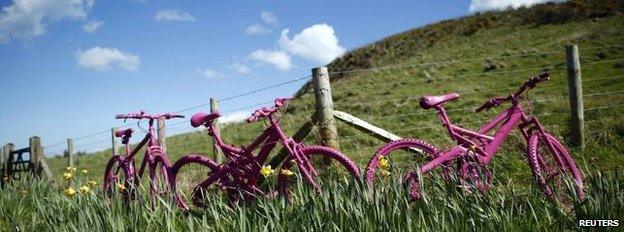
Pink bicycles have been placed in a field near the village of Ballintoy, County Antrim
Northern Ireland is hosting the opening stages of the Giro d'Italia international cycle race between Friday and Sunday.
Here is a guide to the key talking points, route details, travel information and the top cyclists taking part.
Firstly, why is the Giro d'Italia in Northern Ireland?
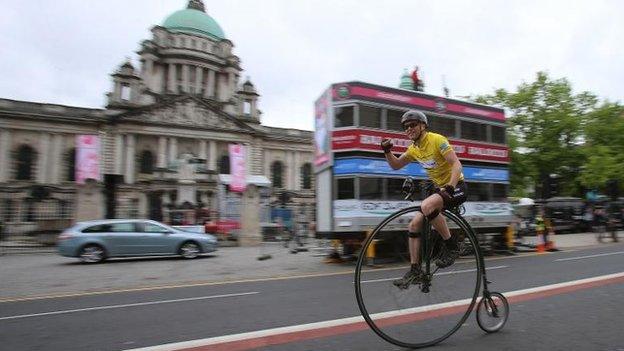
Cyclist Joff Summerfield, who circumnavigated the globe on a penny farthing, rode the time trial route on his old-fashioned bike to raise awareness of the Tour de France in London
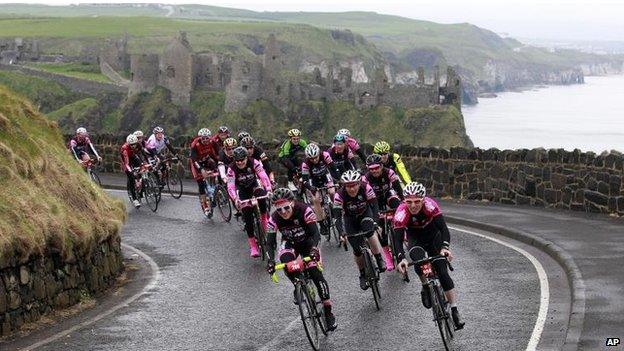
Cyclists pass Dunluce Castle on the Antrim coast, which is on the Giro d'Italia route
While it may seem unusual that such a thoroughly Italian race is beginning in Northern Ireland, it is actually the 11th time it has started abroad.
Belfast beat a strong domestic bid from Venice and one other unnamed European city to bring the Grande Partenza outside mainland Europe for the first time.
Northern Ireland's Department of Enterprise say the total cost of hosting the race would be £4.2m, with £3m of this coming from the department and the European Union.
It is one of cycling's most famous events, and organisers estimate that it will attract about 140,000 spectators.

Why is everything turning pink?

A sheep was dyed pink in Ballintoy, County Antrim
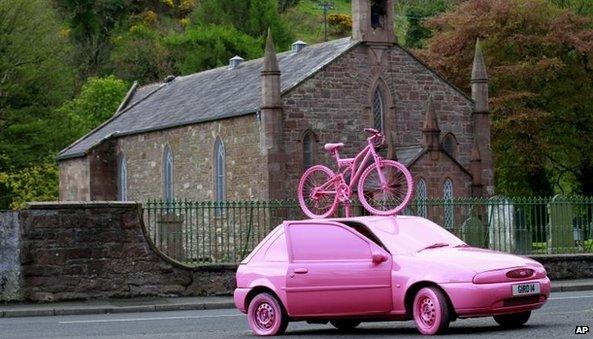
A car and bicycle is painted pink in the village of Cushendall, which welcomes the race on Saturday
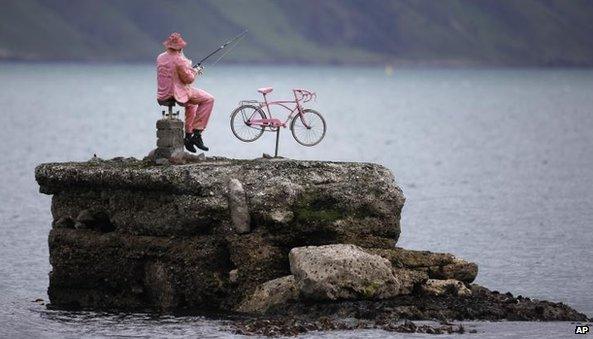
A pink statue of a man fishing next to his bike sits on the rocks at Waterfoot, County Antrim
Pink is the traditional colour of the event, as it is the colour of the jersey worn by the overall leader of the race each day.
Race organisers urged schools, businesses, pubs and restaurants to get into the spirit of things, and many came up with weird and wonderful responses.
A chip shop has been serving up cod dyed pink, players at Armagh Cricket Club ditched their traditional whites for pink kits and a herd of sheep had their wool dyed to welcome the cyclists.
Food dye is being used by a Bushmills chip shop to colour-code its cod, as Mark Simpson reports

What route will the racers follow?
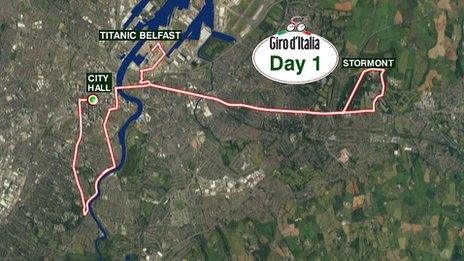
Day one will see cyclists start at Titanic Belfast before passing Stormont and finishing at Belfast City Hall
There are road closures for stage one on Friday between 16:00 and 20:30 BST.
The route starts at the Titanic Quarter and goes along Upper Newtownards Road, Stormont, Newtownards Road, Queen's Bridge, Oxford Street, Ormeau Road, Stranmillis Embankment, University Road, Bradbury Place and Wellington Place, ending at Belfast City Hall.
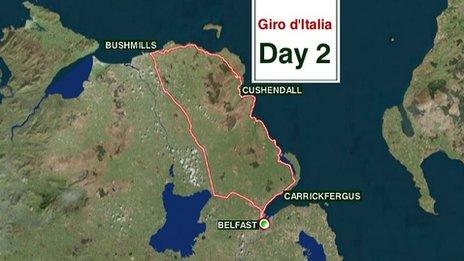
Day two will see cyclists on a tour of the north Antrim coast before returning to Belfast after cycling 218 km
Stage two on Saturday is when the riders will first get to tackle some hills. Road closures begin at 08:00 BST. The race begins at Belfast's Titanic Quarter, and cyclists will pass through Antrim, Ballymena, Ballymoney, Bushmills, Ballycastle, Cushendall, Waterfoot, Carnlough, Glenarm, Ballygally, Larne, Whitehead, Carrickfergus, ending 218km later at Belfast City Hall.
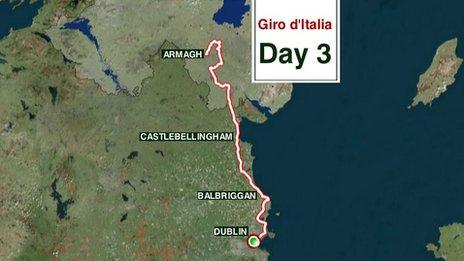
The third day will see the cyclists make their way to Dublin after starting in Armagh
Road closures for stage three on Sunday begin at 07:00 BST. The 187km route begins in Armagh, passing through Loughgall, Richhill, Markethill, Keady, Newtownhamilton and Forkhill in County Armagh, before crossing the Irish border and on to Dublin via Dundalk, Castlebellingham, Ballbriggan and Swords.
Road closures - Trafficwatch NI, external

Will there be much disruption?
1,700 pink and black information signs are being put up around the route
One of the largest traffic management schemes ever seen in Northern Ireland has been put in place.
More than 200 miles of roads will close at various times over the three days.
About 1,700 pink and black information signs were put up along the route to let people know what to expect.
In Belfast, more than 2,000 extra parking spaces for bikes are being made available during the race.
Public transport company Translink is putting on extra services. Because of the road closures, some timetables have changed, and it has advised people to leave extra time for journeys.

Who are the main contenders?
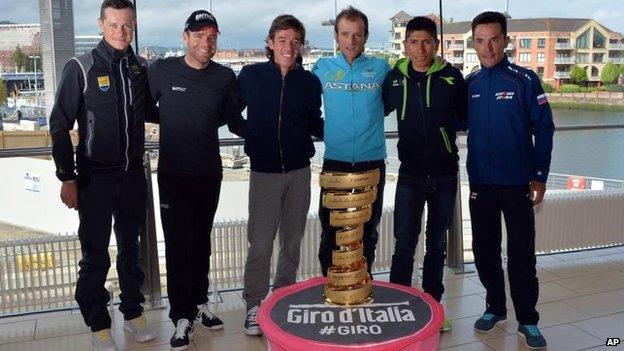
Ireland's Nicholas Roche, Australia's Cadel Evans, Colombia's Rigoberto Uran, Italy's Michele Scarponi, Colombia's Nairo Quintana and Spain's Joaquim Rodriguez
The bookmakers' favourite for overall victory is Movistar's Nairo Quintana.
At his Tour de France debut last year, the 24-year-old Colombian finished second, winning both the white jersey for best young rider and the polka dot jersey for best climber.
Other contenders include Spaniard Joaquim Rodriguez, who won a second Volta a Catalunya in March, and Australian Cadel Evans, who was Tour de France champion in 2011 and Giro winner in 2010.
Garmin's Irish rider Dan Martin could also do well. Defending champion Vincenzo Nibali is not racing.
Omega Pharma-Quick-Step rider Mark Cavendish, who won the red jersey in the Giro's points classification competition last year, has also withdrawn in order to focus on his preparations for the Tour.

What is it worth to the economy?
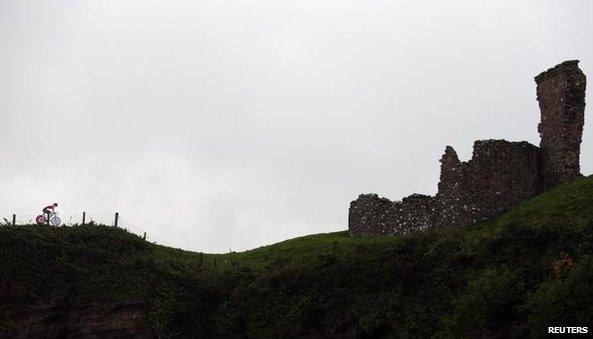
A cardboard cut-out of a bicycle was strapped to a fence beside the ruins of Red Bay Castle
It is costing about £4.2m to stage the races in Northern Ireland, but organisers said it will pay dividends in the long term.
The world's second-largest cycle race is expected to generate about £2.5m from visitors who come to watch the opening stages.
It means the event will initially cost more money than it brings to Northern Ireland.
However, tourism bosses have said it will generate publicity worth at least £10m in the long term.

A pink bicycle was strapped to a fishing boat near the village of Cushendall
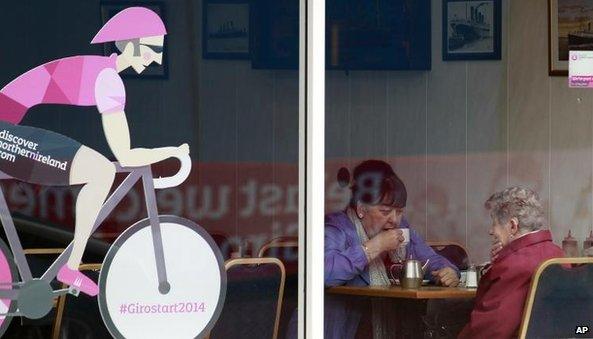
Women sit in an east Belfast café advertising the Giro d'Italia
- Published12 February 2014

- Published10 February 2014
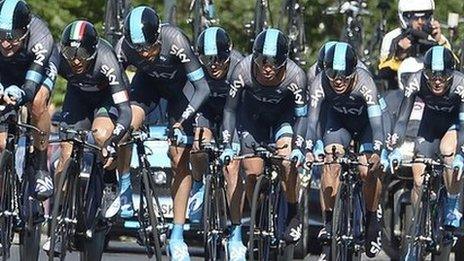
- Published7 February 2014

- Published3 February 2014

- Published2 October 2013
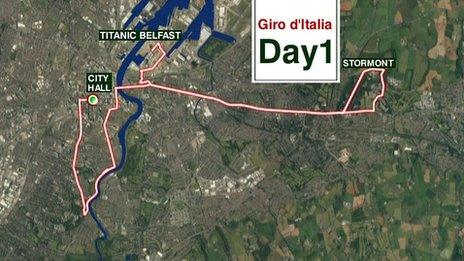
- Attribution
- Published21 February 2013
